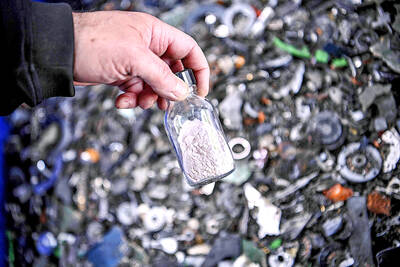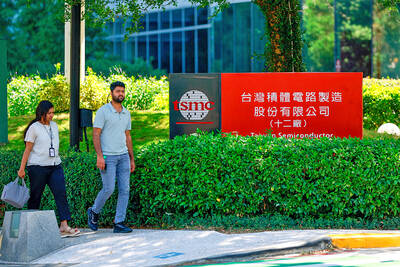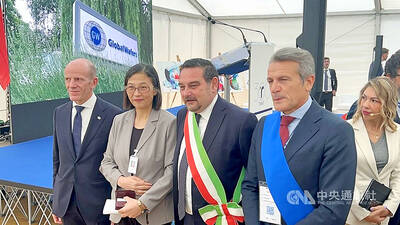Taipei Times: As the world's second-largest maker of consumer electronics, Sony embarked last year on a corporate-restructuring campaign called "Transformation 60." Can you elaborate on this project?
Kunitake Ando: Because the information technology [IT] industry has been expanding, with new players joining the battle, we hope to create new value and growth to become a super global company, as well as a leading consumer brand in the network age by the year 2006, when Sony turns 60.

PHOTO: GEORGE TSORNG, TAIPEI TIMES
Put simply, we'll meet the broadband challenge by integrating all our resources to bring digital entertainment to consumers worldwide. To achieve that goal, we first need to adjust our structure to achieve higher profitability. We will outsource our non-critical operations to China to reduce fixed and variable costs drastically so that we can expand our value-added sector.
At home, we plan to focus on our core businesses and implement convergence strategies, mainly by combining our entertainment electronics, mobile electronics and home electronics operations. Hopefully we can secure a consolidated operating profit margin of at least 10 percent by the end of fiscal year 2006.
TT: Can you tell us about the focus of Sony's business currently?
Ando: We are now trying to introduce high-end innovative products before others do because product differentiation among brands is narrowing. As I said regarding our "Transformation 60" campaign, we are developing unique entertainment electronics that are capable of bringing convergence to audio, video, telecommunication and various IT products by combining hardware, software and even service. I think Sony is in a strong position to attain its goals, as we are the only company that has strong products in all these areas.
TT: You mentioned that product differentiation has decreased over the years. Many have said that Sony's recent products lack the "Sony character," compared to earlier products. How do you respond to that criticism?
Ando: We are aware of this problem and have devoted ourselves to exploring new avenues for our product lines over the past few years. One successful example is the VAIO line of notebook computers. This product line has won kudos for its sleek design and its entertainment features. We have also failed in some cases, of course. For example, we were seeking to design a new type of TV that could break space restrictions and allow viewers to watch TV wherever they go. But it is difficult to convince consumers to buy such a product, as many are content with their current viewing habits. Besides, unique products require unique components, which means high research and development costs. Even so, we won't stop trying to introduce original and novel products that improve consumers' lives.
TT: What is Sony's marketing strategy in the greater-China market?
Ando: The Chinese market is growing with exceptional speed, and Sony is taking advantage of this by moving more manufacturing capacity to China to reduce costs. Nevertheless, Taiwan still plays an important role for Sony in terms of high-end component design and development, engineering power and human resources.
TT: Can you tell us the dollar amount of procurements you made from Taiwan last year, as well as projected procurements for this year?
Ando: In the last fiscal year, from April 2003 to March this year, our procurements from Taiwanese suppliers amounted to about NT$150 billion (US$4.55 billion). We can't disclose orders for this year, but the amount will increase at a double-digit rate.
TT: When are you going to introduce PSX, the PlayStation 2-based digital video recorder that hit the Japanese market in December last year, to the Taiwanese market? Also, as Microsoft Corp seeks to catch up to Sony's PS2 with its Xbox online, are you considering turning PS2 into an online game as well?
Ando: Basically, we have not decided to bring PSX to Taiwanese gamers yet because demand for DVD recorders is not significant here. The market is not mature enough for us to market the product. The market is too small compared to large ones such as the US and Europe, in which we plan to introduce the product in the second half of the year. As for whether we are going to develop PS2 online, we are studying the idea with our ADSL subsidiary, So-net. We will announce our plans once we reach a conclusion.
TT: What is Sony's strategy for the flat-panel business, which your company has shown a strong ambition to engage in?
Ando: Flat-panel displays, especially liquid-crystal displays [LCDs], are important for all Sony products, especially after the transition from cathode ray tubes to plasma display panels to flat panels. Our strategy is to introduce new products ourselves, to make unique products instead of massive ones. We have formed a joint venture through our S-LCD Corp with South Korea's Samsung Electronics Co to produce next-generation LCDs.
Although we will still count on suppliers to manufacture flat panels for us, we are maintaining our own Vega engine technology, which is the key factor in determining the quality of LCDs, to differentiate ourselves from competitors.
The capacity of the new plant will not cut Sony's outsourcing from Taiwan, as Sony currently has a 20-percent market share worldwide, and the new factory can only meet one-third of that demand. In addition to strengthening our relationships with local suppliers such as Chi Mei Optoelectronics Corp (
TT: Many Taiwanese companies, such as BenQ Corp (
Ando: I think there are lots of opportunities for Taiwanese companies to grow into global brands like Sony. I'm impressed by the power and diligence of these young enterprises, including BenQ and Asustek, and also Acer. If their businesses continue to grow as fast as they are growing now, I'm sure that the world market will be dominated by Taiwanese brands in a couple of years.
Actually, in the past, many Japanese companies had ambitions to become the next Sony, but no one ever succeeded. I guess different companies have different characteristics and will develop in their own way.

RECYCLE: Taiwan would aid manufacturers in refining rare earths from discarded appliances, which would fit the nation’s circular economy goals, minister Kung said Taiwan would work with the US and Japan on a proposed cooperation initiative in response to Beijing’s newly announced rare earth export curbs, Minister of Economic Affairs Kung Ming-hsin (龔明鑫) said yesterday. China last week announced new restrictions requiring companies to obtain export licenses if their products contain more than 0.1 percent of Chinese-origin rare earths by value. US Secretary of the Treasury Scott Bessent on Wednesday responded by saying that Beijing was “unreliable” in its rare earths exports, adding that the US would “neither be commanded, nor controlled” by China, several media outlets reported. Japanese Minister of Finance Katsunobu Kato yesterday also

Jensen Huang (黃仁勳), founder and CEO of US-based artificial intelligence chip designer Nvidia Corp and Taiwan Semiconductor Manufacturing Co (TSMC, 台積電) on Friday celebrated the first Nvidia Blackwell wafer produced on US soil. Huang visited TSMC’s advanced wafer fab in the US state of Arizona and joined the Taiwanese chipmaker’s executives to witness the efforts to “build the infrastructure that powers the world’s AI factories, right here in America,” Nvidia said in a statement. At the event, Huang joined Y.L. Wang (王英郎), vice president of operations at TSMC, in signing their names on the Blackwell wafer to

‘DRAMATIC AND POSITIVE’: AI growth would be better than it previously forecast and would stay robust even if the Chinese market became inaccessible for customers, it said Taiwan Semiconductor Manufacturing Co (TSMC, 台積電) yesterday raised its full-year revenue growth outlook after posting record profit for last quarter, despite growing market concern about an artificial intelligence (AI) bubble. The company said it expects revenue to expand about 35 percent year-on-year, driven mainly by faster-than-expected demand for leading-edge chips for AI applications. The world’s biggest contract chipmaker in July projected that revenue this year would expand about 30 percent in US dollar terms. The company also slightly hiked its capital expenditure for this year to US$40 billion to US$42 billion, compared with US$38 billion to US$42 billion it set previously. “AI demand actually

Taiwan-based GlobalWafers Co., the world’s third largest silicon wafer supplier, on Wednesday opened a 12-inch silicon wafer plant in Novara, northern Italy - the country’s most advanced silicon wafer facility to date. The new plant, coded “Fab300,” was launched by GlobalWafers’ Italian subsidiary MEMC Electronics Materials S.p.A at a ceremony attended by Taiwan’s representative to Italy Vincent Tsai (蔡允中), MEMC President Marco Sciamanna and Novara Mayor Alessandro Canelli. GlobalWafers Chairwoman Doris Hsu (徐秀蘭) said the investment marked a milestone in the company’s expansion in Europe, adding that the Novara plant will be powered entirely by renewable energy - a reflection of its